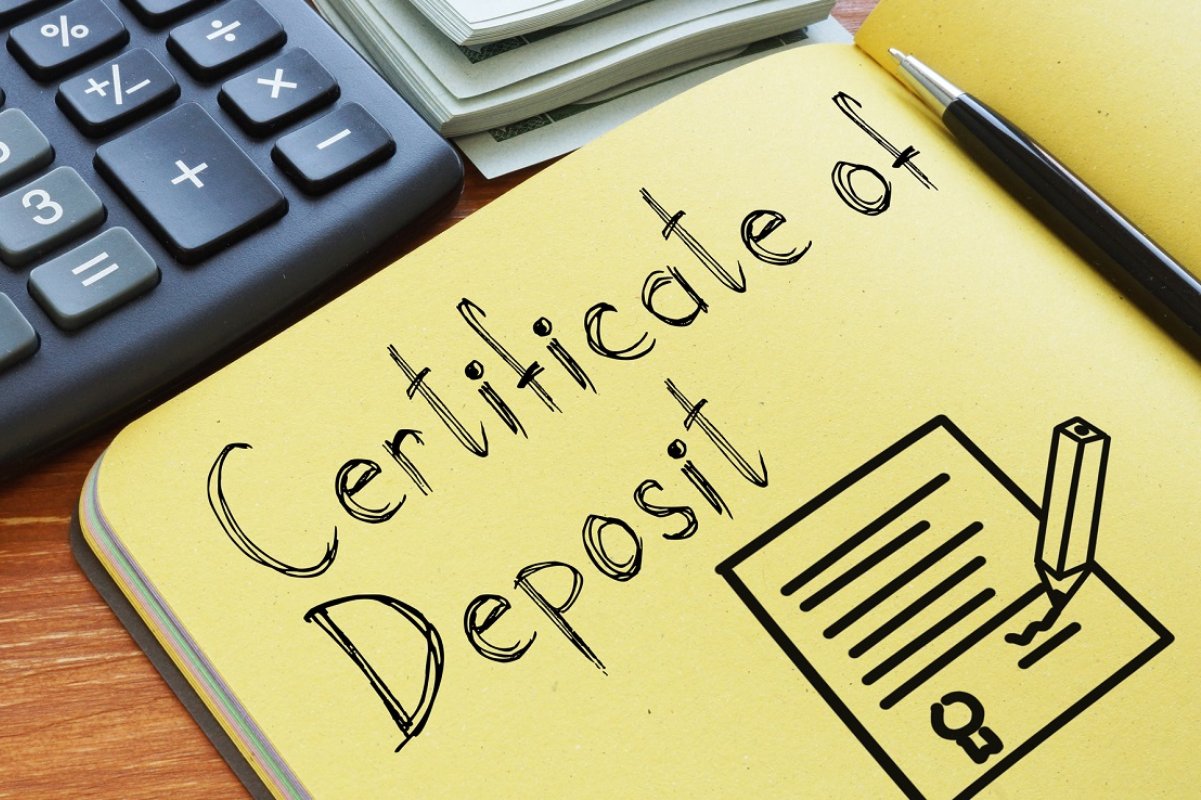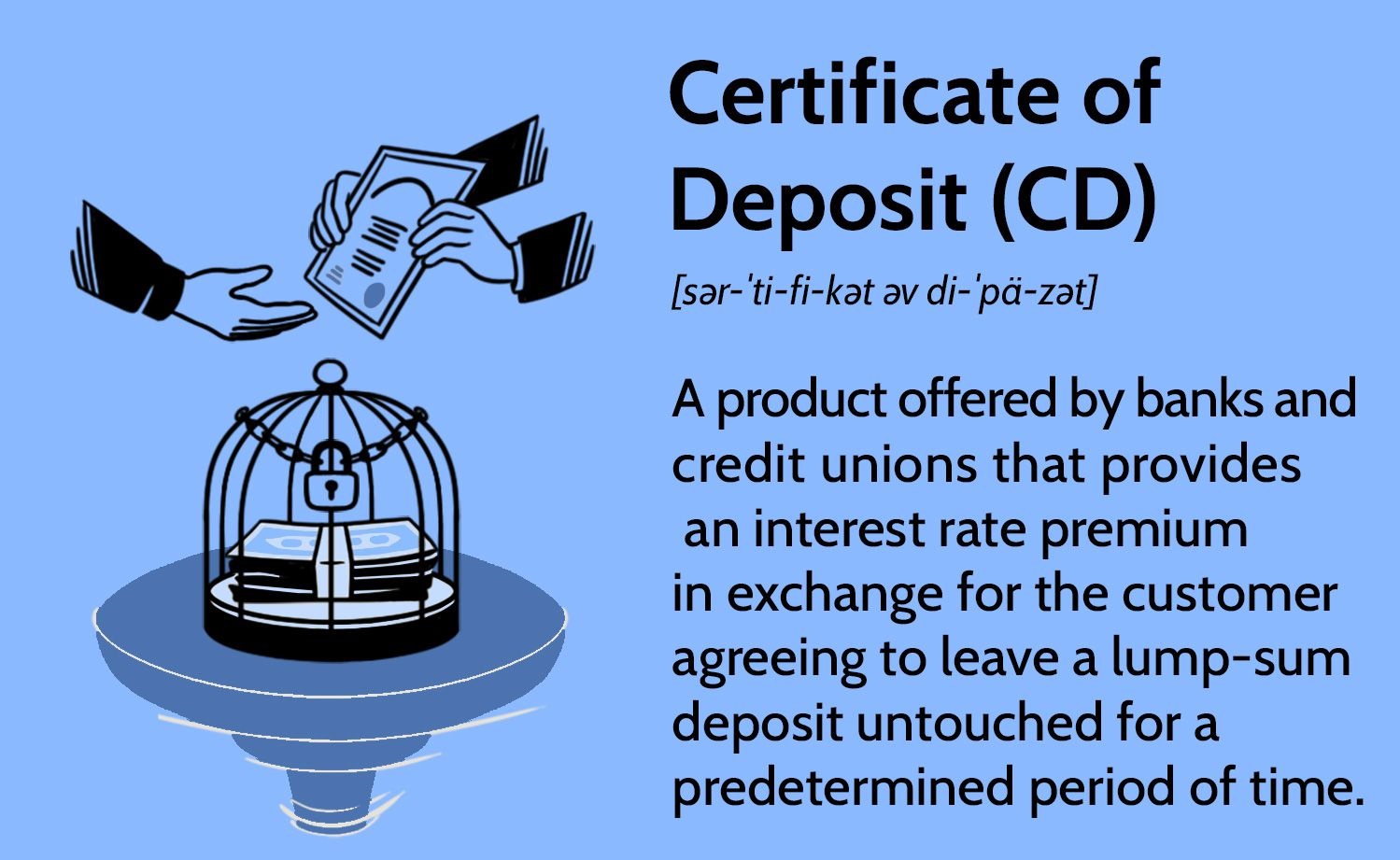Introduction
When it comes to banking and finance, there are countless acronyms and terms that can leave people feeling confused. One such acronym that you may have come across is CD, which stands for Certificate of Deposit. While many of us are familiar with the concept of depositing money into a bank account, a CD offers a unique way to save and grow your money.
A Certificate of Deposit is a type of financial product offered by banks and credit unions. It allows individuals to deposit a specific amount of money for a fixed period of time, usually ranging from a few months to several years. In return for depositing your money, the bank offers a higher interest rate compared to a traditional savings account.
The purpose of a CD is to provide individuals with a safe and low-risk investment option. It is especially popular among those who want to earn interest on their savings without the potential volatility and risks associated with other investment vehicles such as stocks or mutual funds.
In this article, we will explore the ins and outs of CDs in the banking industry. We will delve into how CDs work, the different types available, the benefits and risks associated with investing in CDs, factors to consider before opening a CD account, and how to manage a CD account. By the end of this article, you will have a comprehensive understanding of CDs and whether they might be the right investment option for you.
Definition of CD
A Certificate of Deposit (CD) is a financial instrument offered by banks and credit unions that allows individuals to deposit a specific amount of money for a fixed period of time. It is commonly known as a time deposit as the funds are locked in for a predetermined duration. The duration can vary widely, ranging from a few months to several years, and the interest rates offered on CDs are generally higher than those on traditional savings accounts.
When you open a CD, you essentially lend money to the bank for the agreed-upon term, and in return, the bank promises to pay you a fixed rate of interest over that period. The interest rate is pre-set at the time of opening the CD and remains fixed throughout the term, regardless of any fluctuations in the market.
CDs are considered low-risk investments due to their federally insured status. In the United States, CDs are typically insured by the Federal Deposit Insurance Corporation (FDIC) for up to $250,000 per depositor, per institution. This means that even if the bank were to face financial difficulties, your principal investment is protected.
Unlike other savings accounts, CDs generally have a penalty for early withdrawal. The penalty usually comes in the form of a loss of a portion of the interest earned or, in some cases, a percentage of the principal amount. This penalty acts as an incentive for individuals to keep their funds locked in the CD for the agreed-upon term.
CDs are often used by individuals who have a specific savings goal in mind and are willing to forego immediate access to their funds in exchange for higher interest rates. They are especially popular among those who prioritize safety and stability in their investment choices.
In the next section, we will delve deeper into the purpose and benefits of investing in CDs, giving you a better understanding of why many individuals choose to include them as part of their financial strategy.
Purpose of a CD
The primary purpose of a Certificate of Deposit (CD) is to provide individuals with a safe and low-risk investment option that offers better returns than traditional savings accounts. CDs are attractive to those who prioritize the preservation of their capital and are willing to forego immediate access to their funds in exchange for higher interest rates.
One of the main purposes of a CD is to help individuals meet specific financial goals. Whether you’re saving for a down payment on a house, financing a wedding, or planning for retirement, a CD can provide a secure way to steadily grow your savings over a fixed term. Knowing that your principal investment is protected by FDIC insurance, CDs offer peace of mind, making them an attractive choice for risk-averse investors.
Furthermore, CDs can be an effective tool for diversifying your investment portfolio. By allocating a portion of your savings to a CD, you can balance your investment strategy and reduce the overall risk of your portfolio. This is particularly beneficial during times of market volatility when other investments may experience fluctuations.
Additionally, CDs can act as a hedge against inflation. Since CD interest rates are fixed at the time of opening, they can provide a stable income stream that keeps up with inflation. This makes CDs an appealing option for individuals looking to preserve their purchasing power over time.
Another purpose of CDs is to promote disciplined saving habits. By locking your funds into a CD for a specific term, you are less likely to dip into your savings for impulsive spending. This can be particularly helpful for those who struggle with saving money or those who want to set aside funds for the long term without the temptation to withdraw them.
Overall, the purpose of a CD is to offer individuals a secure saving and investment alternative with a guaranteed return. It provides stability, higher interest rates, and protection of principal, making it a valuable tool for achieving financial goals and maintaining financial well-being.
Next, we will explore how a CD works and the various types available to investors.
How a CD Works
Understanding how a Certificate of Deposit (CD) works is crucial before investing in this financial instrument. When you open a CD, you deposit a specific amount of money with a bank or credit union for a predetermined period of time. This period is known as the “term” or “maturity” of the CD.
During the term of the CD, the deposited funds accrue interest at a fixed rate that was determined at the time of opening the account. The interest rate remains constant throughout the term, regardless of any changes in the market. This allows investors to know exactly how much interest they will earn over the duration of the CD.
At the end of the term, the CD “matures,” and you have several options. One option is to withdraw the funds, including both the principal and the interest earned. Another option is to roll over the CD, which means reinvesting the funds into a new CD with the same or a different financial institution. Rolling over a CD allows you to continue earning interest on your savings without interrupting the growth of your investment.
It’s important to note that early withdrawal from a CD before the maturity date typically incurs a penalty. The penalty is usually a percentage of the interest earned or sometimes even a portion of the principal amount. This penalty acts as an incentive for individuals to keep the funds locked in the CD for the agreed-upon term and discourages them from accessing their money before the maturity date.
When it comes to the payout structure of the interest earned on a CD, there are typically two options: periodic interest payments and cumulative interest payments. With periodic interest payments, you receive the interest earned on a regular schedule, such as monthly, quarterly, or annually. On the other hand, with cumulative interest payments, the interest is added to the principal and paid out in a lump sum at maturity.
Some financial institutions also offer the option of automatically renewing the CD at the end of the term. This means that if you do not instruct them otherwise, the bank or credit union will reinvest the funds into a new CD with the same duration. Automatic renewal can be convenient for individuals who want to maintain a consistent savings strategy.
In the next section, we will discuss the different types of CDs available for investors and the unique features they offer.
Different Types of CDs
Certificate of Deposits (CDs) come in various types, each offering distinct features to cater to different investment preferences and financial goals. Understanding the different types of CDs can help investors choose the most suitable option for their needs.
1. Traditional CDs: These are the most common type of CDs. They have a fixed term and interest rate, with the principal and interest paid out at the end of the term. Traditional CDs are a secure and straightforward investment option, ideal for those seeking stability and guaranteed returns.
2. High-Yield CDs: High-yield CDs offer higher interest rates compared to traditional CDs. They are generally offered by online banks or credit unions. Investors with a higher risk tolerance may opt for high-yield CDs to maximize their earning potential. However, it’s crucial to research and assess the financial stability of the institution offering these CDs.
3. Callable CDs: Callable CDs provide the issuing institution with the option to “call back” the CD before the maturity date. This allows the institution to pay back the principal and accrued interest to investors if interest rates decline. While callable CDs can offer higher initial interest rates, they carry the risk of early termination, potentially limiting the investor’s return.
4. Bump-Up CDs: Bump-up CDs provide investors with the opportunity to increase their interest rate once during the CD’s term. This feature can be advantageous when interest rates rise, allowing investors to capitalize on the higher rates without having to open a new CD. Bump-up CDs are suitable for individuals who want some flexibility while still benefiting from a fixed rate during most of the term.
5. No-Penalty CDs: No-penalty CDs provide investors with the ability to withdraw their funds before the maturity date without incurring any penalties. These CDs are ideal for individuals who value liquidity and may require access to their funds before the term ends. However, due to the added flexibility, the interest rates on no-penalty CDs may be lower than traditional CDs.
6. Jumbo CDs: Jumbo CDs require a larger initial deposit compared to traditional CDs. The minimum deposit amount for jumbo CDs is typically higher, often ranging from $100,000 to $250,000. In return, investors may enjoy higher interest rates. Jumbo CDs are suited for individuals with substantial savings who are looking for increased returns on their investments.
Each type of CD has its own set of pros and cons, and it’s essential to evaluate your financial goals and risk tolerance when deciding which type of CD to invest in. By understanding the different types available, you can make an informed decision that aligns with your investment objectives.
Next, we will explore the benefits and risks associated with investing in CDs to help you further evaluate their suitability for your financial strategy.
Benefits of Investing in CDs
Investing in Certificate of Deposits (CDs) offers several benefits for individuals looking to grow their savings in a safe and controlled manner. Let’s explore some of the key advantages:
1. Guaranteed returns: CDs provide a fixed interest rate for the duration of the term. This means that you can calculate and predict the exact amount of interest you will earn over the investment period. The guarantee of a fixed return offers peace of mind and helps individuals plan their finances more effectively.
2. Capital preservation: Unlike other investment options that carry market risks, CDs are considered low-risk investments. The principal amount invested in a CD is typically insured by the FDIC up to $250,000 per depositor, per institution. This protection ensures that even if the issuing institution were to face financial difficulties, your initial investment is safeguarded.
3. Higher interest rates: CDs generally offer higher interest rates compared to traditional savings accounts. This makes them an attractive option for individuals who want to earn more from their savings without taking on excessive risk. The higher interest rates can significantly boost your overall returns over time.
4. Diverse term options: CDs come with a variety of term lengths, ranging from a few months to several years. This flexibility allows you to select a term that matches your financial goals. Short-term CDs are ideal for emergency funds or short-term savings goals, while long-term CDs can be used for retirement planning or building wealth over an extended period.
5. Disciplined savings habit: Opening a CD requires committing funds for the duration of the term. This can help individuals develop a disciplined savings habit by removing the temptation to spend the money impulsively. By locking away your funds in a CD, you have a dedicated savings plan in place.
6. Easy to open and manage: Opening a CD account is a relatively simple process. Most financial institutions allow you to open a CD online or through their mobile banking app. Additionally, managing a CD requires minimal effort once it is established, as the interest is automatically credited to your account.
7. Suitable for risk-averse investors: If you are risk-averse or have a low tolerance for market fluctuations, CDs can be an ideal investment option. Their stability and guaranteed returns make them a safe haven for protecting and growing your savings.
These benefits make CDs a popular choice for individuals looking to earn steady returns on their investments without exposing their money to excessive risks. However, it is important to consider the potential drawbacks and risks associated with CDs, which we will discuss in the next section.
Risks of Investing in CDs
While Certificate of Deposits (CDs) offer numerous advantages, it is essential to consider the potential risks involved before investing. Here are some risks associated with CDs:
1. Opportunity cost: One primary risk is the opportunity cost of tying up your money in a CD. Since CDs have a fixed term, you cannot access the funds until the maturity date without incurring penalties. This lack of liquidity may prevent you from taking advantage of other investment opportunities or accessing the funds in case of emergencies.
2. Inflation risk: CDs may not keep pace with inflation. While they provide a secure and stable return, the interest rates on CDs may not be enough to offset the impact of inflation over time. This means that the purchasing power of your money may diminish if the rate of inflation exceeds the interest earned on the CD.
3. Fixed interest rates: While the stability of fixed interest rates is a benefit for many investors, it can also be a downside. If interest rates rise significantly after you have invested in a CD, you may miss out on the opportunity to earn higher returns through other investments. This risk can be mitigated by considering CDs with features like bump-up or step-up options.
4. Early withdrawal penalties: If you need to withdraw funds from a CD before the maturity date, you will likely face early withdrawal penalties. These penalties can eat into your interest earnings or even result in a loss of principal. It is important to carefully evaluate your financial needs and ensure that you will not require the funds before the CD matures.
5. Reinvestment risk: When a CD matures, you may face reinvestment risk if prevailing interest rates are lower than the rate on the maturing CD. This means that if you decide to reinvest your funds into a new CD, you might receive a lower interest rate, resulting in a lower return on your investment. Monitoring interest rate trends and planning your reinvestment strategy can mitigate this risk.
6. Credit risk: Although CDs are typically considered low-risk investments, there is still a small degree of credit risk associated with them. This risk arises from the issuing institution’s ability to meet its financial obligations. While most CDs are FDIC-insured, it is essential to choose reputable and financially stable institutions to minimize credit risk.
By understanding these risks, investors can make informed decisions and employ strategies to manage and mitigate them. It is crucial to consider your investment goals, risk tolerance, and financial needs before deciding to invest in CDs.
Next, we will explore the factors to consider before opening a CD account, enabling you to make the most suitable investment choice.
Factors to Consider Before Opening a CD
Before opening a Certificate of Deposit (CD), it is important to carefully consider several factors to ensure that it aligns with your financial goals and needs. Here are some factors to take into account:
1. Time horizon: Evaluate your investment time horizon and determine how long you can comfortably lock your funds in a CD. CDs come with various terms, and the interest rates may vary accordingly. Short-term CDs are suitable for individuals who anticipate the need for funds in the near future, while long-term CDs are better suited for those with longer investment horizons.
2. Interest rates: Compare the interest rates offered by different financial institutions. While interest rates for CDs are generally higher than traditional savings accounts, they can still vary. Research and choose an institution that offers competitive rates to maximize your returns.
3. Penalties for early withdrawal: Understand the penalties associated with early withdrawal from a CD. While it is advisable not to withdraw funds before the maturity date, unforeseen circumstances may arise. Review the penalties, including potential loss of interest earnings or principal amount, and consider your ability to maintain the CD until maturity.
4. Deposit amount: Determine the minimum deposit requirement for opening a CD. Some institutions have higher minimum deposit amounts for certain types of CDs, such as jumbo CDs. Ensure that the required deposit aligns with your financial capability.
5. FDIC insurance: Confirm that the financial institution offering the CD is FDIC-insured. FDIC insurance provides protection for your deposits up to $250,000 per depositor, per institution. This insurance is crucial for safeguarding your principal investment in case the institution faces financial difficulties.
6. Interest payout frequency: Consider how often the CD pays interest, whether it is monthly, quarterly, annually, or at maturity. Some individuals prefer receiving regular interest payments to supplement their income, while others prefer cumulative interest payments at maturity.
7. Relationship with the institution: Evaluate your existing relationship with the financial institution offering the CD. Some institutions provide additional benefits or higher interest rates to loyal customers or account holders. Check if there are any loyalty programs or relationship-based incentives that can enhance the value of your CD investment.
8. Financial goals and risk tolerance: Assess your financial goals and risk tolerance to determine if a CD is the right investment choice for you. CDs are generally considered low-risk investments, but they may not offer the same potential for growth as higher-risk investments like stocks or mutual funds. If your goal is capital preservation and stability, a CD may be a suitable option.
By carefully considering these factors, you can make an informed decision about opening a CD account that aligns with your financial objectives and risk tolerance.
Next, we will discuss the process of opening a CD account and the typical terms and conditions involved.
How to Open a CD Account
Opening a Certificate of Deposit (CD) account is a straightforward process. Here is a step-by-step guide on how to open a CD account:
1. Research and compare financial institutions: Start by researching various banks or credit unions that offer CDs. Look for reputable institutions with competitive interest rates, favorable terms, and reliable customer service.
2. Determine your investment amount: Decide how much money you want to invest in the CD. Different institutions may have different minimum deposit requirements, so ensure that your investment amount meets their criteria.
3. Choose the term duration: Consider your financial goals and time horizon to select the appropriate term duration for the CD. Evaluate the available options, such as short-term, medium-term, or long-term CDs, and opt for the duration that best fits your needs.
4. Contact the financial institution: Reach out to the chosen financial institution to inquire about opening a CD account. You can either visit a local branch, contact them by phone, or explore their online banking platform.
5. Provide necessary documentation: Prepare the required documentation, which typically includes identification proof (such as a driver’s license or a passport) and your Social Security number or taxpayer identification number. Have these documents readily available when applying for the CD account.
6. Fill out the application form: Complete the CD application form provided by the financial institution. The form will ask for personal information, investment amount, term duration, and any additional specifications, such as interest payout frequency.
7. Fund the CD account: Determine how you will fund the CD account. You can choose to transfer funds from an existing account with the same institution or initiate an external transfer from another financial institution. Some institutions may also accept a check or cash deposit.
8. Review and sign the disclosures: Carefully review the terms and conditions, including any applicable disclosures, associated with the CD account. This includes information about early withdrawal penalties, interest rates, renewal options, and other terms specific to the CD.
9. Submit the application: Once you have reviewed and signed all the required documents, submit your application to the financial institution. Depending on the chosen method of application (in-person, phone, or online), follow their specific instructions for submission.
10. Receive confirmation and account details: After submitting the application, the financial institution will provide you with confirmation of the CD account opening. You will receive account details, including the CD account number, the term duration, the interest rate, and any other relevant information.
11. Fund the CD account: Within a specified timeframe, fund the CD account with the agreed-upon investment amount. This can typically be done through a transfer or deposit as per the instructions provided by the financial institution.
Once your CD account is funded, the financial institution will begin the term, and your funds will start earning interest based on the agreed-upon terms.
Remember to keep a record of your CD account details, including the maturity date, renewal options, and any important dates or instructions provided by the financial institution. Regularly monitor your account and ensure that it aligns with your investment goals.
In the next section, we will discuss common terms and conditions associated with CD accounts to provide a clearer understanding of how to manage the account effectively.
CD Account Terms and Conditions
When opening a Certificate of Deposit (CD) account, it is crucial to familiarize yourself with the terms and conditions associated with the account. Here are some common terms and conditions that you should be aware of:
1. Maturity date: The maturity date is the predetermined date when the CD term ends, and you can access your funds without penalty. It is important to note this date and plan accordingly to avoid any unintended penalties.
2. Early withdrawal penalties: Most CDs impose penalties for withdrawing funds before the maturity date. The penalty amount varies but is typically a percentage of the interest earned or a fixed amount. Make sure you understand these penalties before opening a CD, as they can significantly impact your returns.
3. Interest rate: The interest rate is fixed at the time of account opening and remains constant throughout the term of the CD. It is essential to review and understand the interest rate being offered before committing to the investment.
4. Interest payout frequency: CDs may offer different options for receiving interest payments. Common payout frequencies include monthly, quarterly, annually, or at maturity. Determine which payout frequency aligns with your financial goals and needs.
5. Reinvestment options: As your CD approaches maturity, you will have the option to renew or reinvest the funds. Evaluate the reinvestment options provided by the financial institution, including the offered interest rate for the renewed CD.
6. Automatic renewal: Some CDs have an automatic renewal feature which automatically reinvests the funds into a new CD with the same terms. If you do not wish to renew, make sure to inform the financial institution before the maturity date to avoid automatic renewal.
7. FDIC insurance: Ensure that the financial institution offering the CD has FDIC insurance. FDIC insurance guarantees that your deposits are protected up to $250,000 per depositor, per institution, in case the bank or credit union fails.
8. Account statements: Regularly review your CD account statements to track the progress of your investment. These statements provide details of the interest earned, account balance, and any transactions related to the CD.
9. Account closure: If you decide to close your CD account before the maturity date, verify the procedure and any associated fees with the financial institution. Understand the terms and conditions for early closure to properly evaluate the financial implications.
10. Tax reporting: Interest earned on CDs is generally subject to income tax. Ensure that you understand the tax reporting requirements and consult with a tax professional for guidance on reporting CD-related income.
It is crucial to carefully read and comprehend the terms and conditions provided by the financial institution. If you have any questions or require clarification, reach out to the institution’s customer service department or a representative for assistance. Understanding the terms and conditions will help you effectively manage your CD account and make informed decisions regarding your investment.
In the next section, we will explore how to effectively manage a CD account and maximize the benefits of your investment.
Managing a CD Account
Managing a Certificate of Deposit (CD) account involves taking certain steps to ensure that your investment remains on track and aligns with your financial goals. Here are some key factors to consider when managing a CD account:
1. Track maturity date: Stay aware of the maturity date of your CD. Mark it on your calendar or set reminders to ensure that you prepare for the funds becoming available or make decisions regarding renewing or withdrawing the funds.
2. Renewing or withdrawing at maturity: As the CD approaches maturity, evaluate your financial goals and market conditions to decide whether to renew the CD or withdraw the funds. If you plan to renew, review the available options and consider any changing financial needs or investment opportunities.
3. Consider ladder strategies: To maximize your returns and maintain liquidity, consider implementing a CD ladder strategy. This involves opening multiple CDs with different maturity dates. As each CD matures, you have the option to reinvest the funds or access them if needed, providing flexibility while still benefiting from higher interest rates.
4. Manage early withdrawal penalties: If you anticipate the possibility of needing funds before the maturity date, be aware of the early withdrawal penalties associated with your CD. Carefully consider any potential financial constraints or emergencies that may require access to the funds and plan accordingly.
5. Review interest rates: Keep an eye on prevailing interest rates and compare them with the rate on your CD. If market rates increase significantly, you may miss out on higher returns by keeping your funds locked in a CD. Regularly assess the interest rate environment to make informed decisions about renewing or allocating your funds.
6. Maintain account records: Keep well-organized records of your CD account statements, including confirmation of account opening, maturity dates, interest rates, and other important details. Having these records readily available will help you track the progress of your investment and provide necessary information for tax reporting purposes.
7. Review account statements: Regularly review the account statements provided by the financial institution. Monitor the interest earned, account balance, and any transactions related to your CD. Timely detection of any errors or discrepancies will enable you to address them promptly with the institution’s customer service.
8. Stay informed: Stay updated on changes in the CD market, interest rate trends, and any updates or policy changes from the financial institution. Stay alert to any notifications or communications from the institution that may affect your CD account.
Remember that managing a CD account requires conscious attention and periodic evaluation. Regularly assess your financial goals and needs to determine if adjustments to your CD strategy are necessary. By effectively managing your CD account, you can make the most of your investment and potentially achieve your financial objectives.
In the next section, we will discuss the tax implications associated with CDs, providing an overview of how earnings from CDs are taxed.
Tax Implications of CDs
Understanding the tax implications of investing in Certificate of Deposits (CDs) is crucial to accurately report your earnings and comply with tax regulations. Here is an overview of the key tax considerations related to CDs:
1. Interest income: The interest earned on CDs is generally considered taxable income. At the end of each tax year, the financial institution will provide a Form 1099-INT that reports the interest earned from the CD. You must include this income when filing your annual income tax return.
2. Taxable interest rate: The taxable interest rate is the portion of the interest earned that is subject to income tax. It is important to differentiate between the actual interest rate on the CD and the taxable interest rate, as they may not be the same due to various tax regulations and exemptions. Consult with a tax professional or refer to IRS guidelines for the current taxable interest rates.
3. Tax reporting: Include the interest earned from CDs on your income tax return. Report the interest income using the appropriate forms, such as Schedule B for Form 1040. Ensure that you accurately report all taxable interest from CDs to avoid potential tax penalties or audits.
4. Tax-exempt CDs: In some cases, CDs may be tax-exempt. For example, if you purchase CDs issued by a state or local government entity, the interest earned may be exempt from federal income tax. Additionally, certain CDs may qualify for tax benefits under specific programs, such as education savings accounts or health savings accounts. Verify the tax-exempt status of your CD with the issuing institution and consult with a tax professional if necessary.
5. CD rollovers: If you choose to rollover funds from a matured CD into a new CD within the allowed time frame, the tax implications depend on the type of rollover. In a direct rollover, where the funds are transferred directly from one CD to another, there are typically no immediate tax consequences. However, if you receive the funds from the matured CD and then deposit them into a new CD, it may be considered a taxable event and subject to taxes.
6. Early withdrawal penalties: Even if you incur penalties for early withdrawal from a CD, the interest earned up to that point is still considered taxable income. Any penalties deducted from the principal balance are not deductible for tax purposes.
7. State and local taxes: Depending on your jurisdiction, interest income from CDs may also be subject to state and local income taxes. Research the tax laws specific to your state and locality to understand the tax obligations related to CD earnings.
It is crucial to keep accurate records of the interest earned from your CDs and file your taxes accordingly. Consulting with a tax professional or using tax software can help ensure that you comply with all tax regulations and maximize any potential deductions or exemptions.
Remember that tax laws and regulations can change, and it is important to stay informed about any updates or changes that may impact your CD investments.
In the next section, we will explore alternatives to CDs for individuals seeking different investment options or those looking to diversify their portfolios.
Alternatives to CDs
While Certificate of Deposits (CDs) offer stability and guaranteed returns, there are several alternative investment options available for individuals looking to diversify their portfolios or explore different investment avenues. Here are some common alternatives to consider:
1. Stocks: Investing in stocks offers the potential for higher returns compared to CDs. Stocks represent ownership in a company and can provide capital appreciation through price appreciation or dividends. However, investing in stocks involves higher risk due to market fluctuations and requires careful research and analysis.
2. Bonds: Bonds are fixed-income securities issued by governments, municipalities, or corporations. They offer regular interest payments and return of principal upon maturity. Bonds typically carry less risk than stocks but can still have fluctuations in value. Government bonds, municipal bonds, and corporate bonds are common types.
3. Mutual Funds: Mutual funds pool money from multiple investors to invest in a diversified portfolio of stocks, bonds, or other assets. They are managed by professionals who make investment decisions on behalf of the investors. Mutual funds offer diversification and professional management but come with fees and expenses.
4. Exchange-Traded Funds (ETFs): ETFs are similar to mutual funds but trade on stock exchanges like individual stocks. ETFs offer diversification and flexibility, allowing investors to gain exposure to specific sectors, industries, or asset classes. They are typically more cost-effective than mutual funds.
5. Real Estate Investment Trusts (REITs): REITs allow investors to invest in real estate properties without directly owning them. REITs generate income through rents from commercial properties, and investors can benefit from potential appreciation in property values. REITs can be publicly traded or non-traded, with varying levels of liquidity.
6. Money Market Accounts: Money market accounts are similar to savings accounts but offer higher interest rates. They invest in short-term and low-risk securities like Treasury bills and certificates of deposit. Money market accounts provide easy access to funds while still earning a higher interest rate compared to traditional savings accounts.
7. Peer-to-Peer Lending: Peer-to-peer lending platforms connect borrowers directly with lenders, cutting out traditional financial institutions. As a lender, you can earn interest by lending money to individuals or small businesses. This alternative investment allows investors to diversify their portfolio and potentially earn higher returns.
8. Commodities: Investing in commodities such as gold, silver, oil, or agricultural products provides exposure to different asset classes. Commodities can act as a hedge against inflation or provide a store of value during economic downturns. However, commodities can be volatile and require knowledge of market trends.
It’s important to note that alternative investments generally carry higher risks than CDs. It’s crucial to conduct thorough research, assess your risk tolerance, and consider your financial goals before allocating funds to alternative investments.
Consider diversifying your portfolio by combining different investment options according to your risk tolerance and investment objectives. Working with a financial advisor can help determine the mix of investments that align with your individual financial situation and goals.
In the final section, we will summarize the key points discussed throughout the article and reiterate the benefits and considerations of investing in CDs.
Conclusion
Certificate of Deposits (CDs) offer a secure and low-risk investment option for individuals looking to grow their savings. By depositing funds in a CD, investors can benefit from guaranteed returns, higher interest rates, and capital preservation. However, it is essential to consider various factors before opening a CD account, such as time horizon, interest rates, early withdrawal penalties, and FDIC insurance.
Investing in CDs comes with several benefits, including guaranteed returns, capital preservation, and disciplined savings habits. They offer diversification options, flexibility in terms of maturity dates, and ease of account management. CDs are particularly well-suited for risk-averse investors seeking stable returns.
However, it is important to be aware of the potential risks associated with CDs, such as the opportunity cost of limited liquidity, inflation risk, and the impact of fixed interest rates during rising rate environments. Early withdrawal penalties and credit risk of the issuing institution should also be considered.
If CDs are not suitable for your investment needs, there are alternative options available such as stocks, bonds, mutual funds, and real estate investment trusts (REITs). These alternatives offer potential for higher returns, but they also come with increased risks and market volatility.
Managing a CD account involves tracking the maturity date, assessing renewal or withdrawal options, and monitoring early withdrawal penalties. Regularly reviewing account statements and staying informed about interest rates and market conditions is critical.
Lastly, understanding the tax implications of investing in CDs is vital. Interest earned on CDs is generally considered taxable income, and proper tax reporting is required to comply with regulations. Consider consulting a tax professional to ensure accurate reporting and maximize tax benefits.
In conclusion, investing in CDs can be a valuable component of a well-diversified investment portfolio. They provide stability, guaranteed returns, and protection of principal. By carefully considering the terms, risks, and alternatives, individuals can make informed decisions that align with their financial goals and risk tolerance.
Remember, each individual’s financial situation is unique, and it is important to evaluate personal circumstances and consult with a financial advisor before making any investment decisions. With proper research and understanding, CDs can be an effective tool for achieving financial goals and maintaining financial well-being.

























